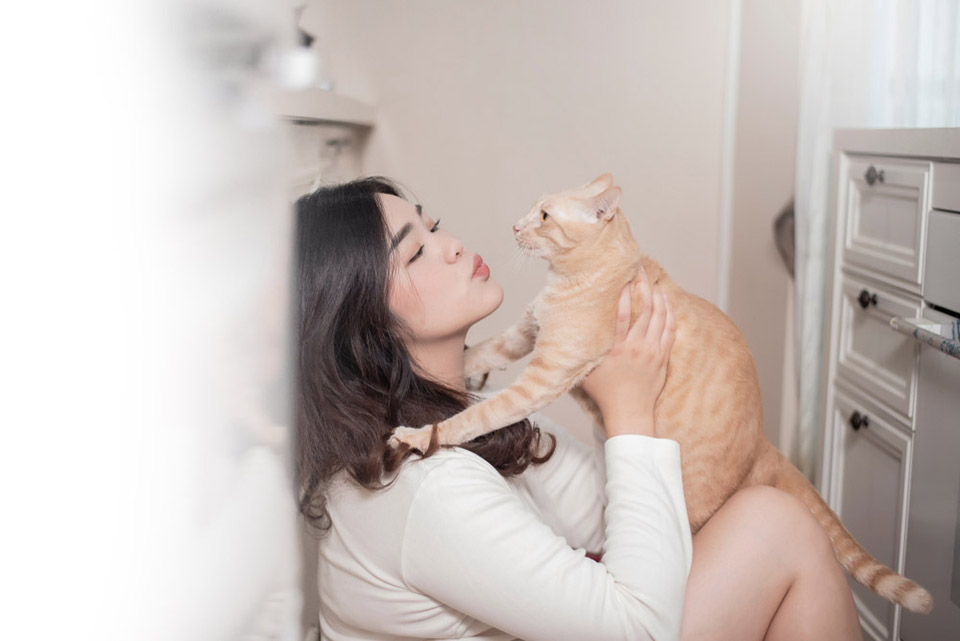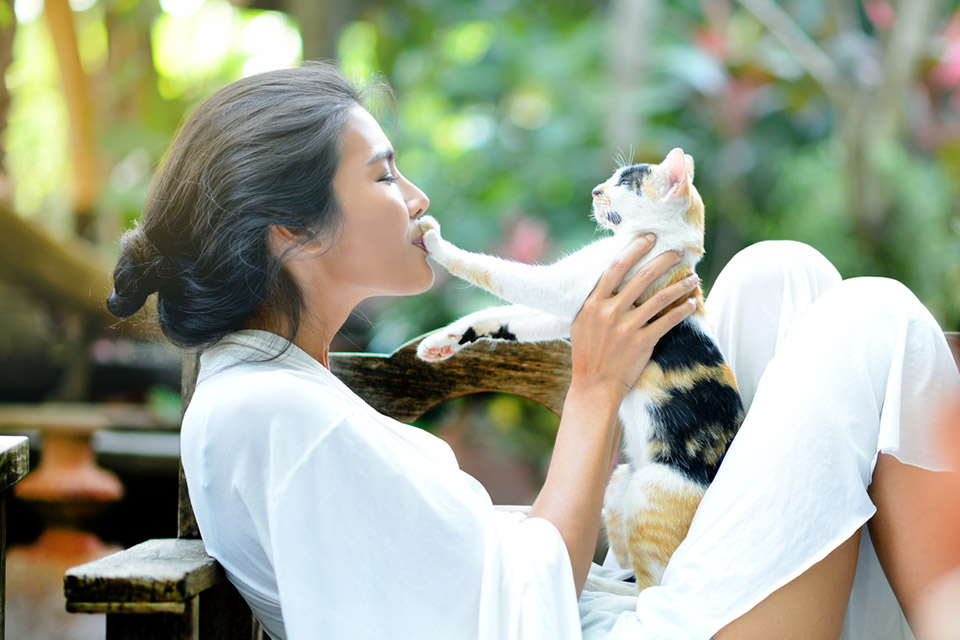WHAT YOU SHOULD KNOW ABOUT FELINE PANCREATITIS
Feline pancreatitis is a condition of the pancreas that causes it to become swollen and inflamed. Even though pancreatitis in cats is common, it is hard to diag-nose, making it a growing concern for middle-aged obese or overweight cats.
About one out of every 50 cats is affected, according to the Cornell Feline Health Center. It can be either acute (sudden) or chronic (ongoing), and mild or severe.
WHAT’S THE PANCREAS, ANYWAY?
The pancreas is a little organ between your kitty’s stomach and intestines. It produces the hormones insulin and glucagon, which regulate your cat’s blood sugar.
The pancreas also produces enzymes that help in the digestion of fats, proteins, and carbohy-drates.
EXPERT OPINION
We spoke to Dr. Mariane C. Torres, resident veterinarian at The Pet Project Vet Clinic, about the warning signs of feline pancreatitis and how to help furry friends avoid this condition.
“Feline pancreatitis is a common cat disease,” explains Dr. Mariane, “but the lack of obvious observable clinical signs in most cats and the difficulty in diagnosing the condition makes the disease less prevalent. The disease can go unnoticed, and pancreatic lesions can be an incidental finding when trying to diagnose other cat diseases.” That means that a correct feline pancreatitis diagnosis can be obscured by other conditions that your cat may also be suffering.
WARNING SIGNS
Because the pancreas does so many things in-side your cat’s body, a problem with the pancre-as can look like many other medical conditions. These signs can be subtle and easy to miss.
Dr. Marianne says, “Some cats with acute pan-creatitis exhibit signs of weakness, inappetence, dehydration, vomiting, abdominal pain, diar-rhea, difficulty in breathing, weight loss, jaun-dice, and uncontrolled or uncoordinated volun-tary muscle movement. If a cat recovers after an acute pancreatic flareup, it is likely to remain with considerable functional tissue impairment. Continuing bouts leads to chronic pancreatitis.”

CARING FOR A RECOVERING CATA
cat with acute feline pancreatitis needs hospitalization and is under serious risk. However, cats who suffer from chronic pancreatitis might need periodic visits to the vet, with their condition possibly managed at home.
Once your feline friend gets home from the vet, feed your cat as soon as possible if they have an appetite and are not vomit-ing. If your cat is vomiting frequently but is not at risk for fatty liver disease, your vet might suggest reintroducing food over a few days. Cats with fatty liver disease need immediate nutritional support to prevent life-threatening liver problems.

RISK FACTORS
Unfortunately, the exact causes of most feline pancre-atitis cases are unknown. It can be associated with your feline friend ingesting poi-son, becoming infected with parasites, or even experienc-ing physical trauma.
Dr. Mariane says, “There is no established age, breed, or sex predisposition in feline pancreatitis. In most cats with pancreatitis, the cause is unknown. Therefore, ways to prevent the development of pancreatitis [are] not yet known. But other potential causes are toxicity, trauma, and infection.”
Additionally, there might be a dietary link to feline pancreatitis. “There is now an experimental study which shows that dietary fat intake does not induce pancreatitis,” Dr. Mariane explains. “However, in cats that are already diagnosed with pancreatitis, changing to a low-fat diet (Hill’s ID, Royal Canin Gastrointestinal, Eukanu-ba Intestinal, etc.) apparently reduces acute flareups and pain after eating.”
DOWN THE TUBE
A cat with pancreatitis who is unable to eat on their own might need a feeding tube.
Your vet will talk to you about the various options and show you how to administer food, water and medications through the feeding tube. Although feeding tubes might look scary and painful for your cat, they are actu-ally simple to use, gentle on your cat, and most impor-tantly, crucial in delivering critical calories and nutri-ents while your cat recovers.

VETS TO THE RESCUE
So how do you care for a cat with pancreatitis? “Treatment of pancreatitis depends on the se-verity of the disease [and on the symptoms],” says Dr. Mariane. “Intravenous fluid therapy is important to reverse dehydration and correct electrolyte imbal-ance associated with vomiting.”
Aside from IV therapy, there are other reasons to hospitalize. “Pancreatitis is also usually a painful condition,” says Dr. Mariane. “Hospitalized patients are monitored for pain, and analgesia is administered as necessary. Cats with no appetite are fed frequent, small, low-fat food within 48 hours, and feeding tubes are placed if needed.”
The vet may also give your cat other medicines. “Other drugs, such as an-tiemetics to manage acute vomiting, gastroprotectants to prevent gastrodu-odenal ulceration, and antibiotics for infectious complications, are adminis-tered [as needed]. Cats with pancreatitis are also likely to benefit to Vitamin B12 supplementation. [The outcome] will depend on the severity of the condition at presentation.”
CARING FOR A RECOVERING CAT
A cat with acute feline pancreatitis needs hospital-ization and is under serious risk. However, cats who suffer from chronic pancreatitis might need periodic visits to the vet, with their condition possibly managed at home.
Once your feline friend gets home from the vet, feed your cat as soon as possible if they have an appetite and are not vomiting. If your cat is vomiting frequent-ly but is not at risk for fatty liver disease, your vet might suggest reintroducing food over a few days. Cats with fatty liver disease need immediate nutrition-al support to prevent life-threatening liver problems.

CATS AND DOGS
Although both our canine and feline friends are at risk for pancre-atitis, this condition manifests differently in both. “Clinical signs in most cats with pancreatitis are unsurprisingly mild and unspecific, to the point that several bouts of mild flareups could take place for months or years before veterinary attention is sought,” says Dr. Mariane. “Dogs with severe acute pancreatitis have more marked signs, like obvious pain in the abdomen, persistent vomiting, the so-called ‘praying’ stance (forelegs on the floor and hind legs stand-ing), collapse, and shock.”
How dogs and cats are diagnosed – and what other conditions occur with the pancreatitis – are different as well. “Cats with pancreatitis are more at risk than dogs for concurrent diseases in neighboring organs (liver, gall bladder, small intestines), such as cholangiohepa-titis, hepatic lipidosis, and inflammatory bowel disease. These pan-creatitis-associated diseases are mainly attributed to cats [having a duct system that connects the pancreas to these organs. They have] a single major pancreatic duct joining the common bile duct before entering duodenal papilla. Meanwhile, dogs usually have two pancreatic ducts.”
Dr. Mariane adds that pancreatitis in dogs can be fatal if the canine has another endocrine disease, such as hypothyroidism, hyperadrenocorti-cism, or diabetes mellitus.

LIFE WITH PANCREATITIS
Although acute and severe cases of feline pancreatitis do need hospital-ization and specialized care, many forms of feline pancreatitis are actu-ally quite mild and non-threatening. Learning the signs and acting quick-ly is the best way to maintain your feline friend’s health.






